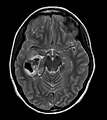Pleomorphic xanthoastrocytoma
Jump to navigation
Jump to search
The printable version is no longer supported and may have rendering errors. Please update your browser bookmarks and please use the default browser print function instead.
| Pleomorphic xanthoastrocytoma | |
|---|---|
| Diagnosis in short | |
 Pleomorphic xanthoastrocytoma. | |
|
| |
| LM | marked nuclear atypia, eosinophilic granular bodies - very common, inflammation (chronic), no necrosis |
| Site | brain - typical temporal lobe |
|
| |
| Clinical history | seizure, children & young adults |
Pleomorphic xanthoastrocytoma, abbreviated PXA, is neuropathology tumour classically associated with seizures in children.
General
Features:
- Rare (less than 1% of all astrocytic tumors).
- Classically in the temporal lobe in children and young adults.
- Associated with seizures.
- Moderately aggressive (WHO Grade II).[1]
- Anaplastic PXA (grade III) - rare. [2]
- ICD-O: 9424/3.
Gross
- Temporal lobe - classic.
- Usually assoc. with the leptomeninges,[1] i.e. superficial (in up 96%).
Microscopic
Features:[3]
- Fibrillary background.
- Large cells with marked nuclear atypia.
- Multinuclear cells possible.
- Reticulin meshwork.
- Lipidized cells.
- Eosinophilic granular bodies - very common.[1]
- Inflammatory cells (lymophocytic perivascular cuffs).
Grading
- Grade II: Mitotic activity is low, no necrosis.
- Grade III anaplastic PXA: more than 5/10 HPF, may have necrosis.
Notes: Anaplastic PXA was introduced in the WHO2016 revision as a distinct entity. In the past, the tumor was called PXA with anaplastic features.
DDx:
Images
www:
- Pleomorphic xanthoastrocytoma - several images (upmc.edu).
- Pleomorphic xanthoastrocytoma with anaplasia - another case - several images (upmc.edu).
- Pleomorphic xanthoastrocytoma with anaplasia - case 3 - several images (upmc.edu).
- Cerebellar pleomorphic xanthoastrocytoma - case 4 - several image (upmc.edu).
Stains
- Reticulin stain - intercellular, prominent.[4]
Image:
IHC
- GFAP +ve.
- S-100 +ve.
- CD68 +ve.
- CD34 frequently.
- MAP2+ve and Synapto+ve pleomorphic cells
- MIB-1 usually low.
Molecular
See also
References
- ↑ 1.0 1.1 1.2 Fouladi, M.; Jenkins, J.; Burger, P.; Langston, J.; Merchant, T.; Heideman, R.; Thompson, S.; Sanford, A. et al. (Jul 2001). "Pleomorphic xanthoastrocytoma: favorable outcome after complete surgical resection.". Neuro Oncol 3 (3): 184-92. PMID 11465399.
- ↑ Louis, DN.; Perry, A.; Reifenberger, G.; von Deimling, A.; Figarella-Branger, D.; Cavenee, WK.; Ohgaki, H.; Wiestler, OD. et al. (Jun 2016). "The 2016 World Health Organization Classification of Tumors of the Central Nervous System: a summary.". Acta Neuropathol 131 (6): 803-20. doi:10.1007/s00401-016-1545-1. PMID 27157931.
- ↑ Kumar, Vinay; Abbas, Abul K.; Fausto, Nelson; Aster, Jon (2009). Robbins and Cotran pathologic basis of disease (8th ed.). Elsevier Saunders. pp. 1333. ISBN 978-1416031215.
- ↑ 4.0 4.1 Dias-Santagata, D.; Lam, Q.; Vernovsky, K.; Vena, N.; Lennerz, JK.; Borger, DR.; Batchelor, TT.; Ligon, KL. et al. (2011). "BRAF V600E mutations are common in pleomorphic xanthoastrocytoma: diagnostic and therapeutic implications.". PLoS One 6 (3): e17948. doi:10.1371/journal.pone.0017948. PMID 21479234.
- ↑ Schindler, G.; Capper, D.; Meyer, J.; Janzarik, W.; Omran, H.; Herold-Mende, C.; Schmieder, K.; Wesseling, P. et al. (Mar 2011). "Analysis of BRAF V600E mutation in 1,320 nervous system tumors reveals high mutation frequencies in pleomorphic xanthoastrocytoma, ganglioglioma and extra-cerebellar pilocytic astrocytoma.". Acta Neuropathol 121 (3): 397-405. doi:10.1007/s00401-011-0802-6. PMID 21274720.
- ↑ Koelsche, C.; Sahm, F.; Wöhrer, A.; Jeibmann, A.; Schittenhelm, J.; Kohlhof, P.; Preusser, M.; Romeike, B. et al. (Apr 2014). "BRAF-mutated pleomorphic xanthoastrocytoma is associated with temporal location, reticulin fiber deposition and CD34 expression.". Brain Pathol 24 (3): 221-9. doi:10.1111/bpa.12111. PMID 24345274.











